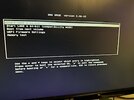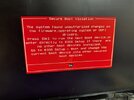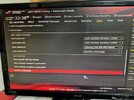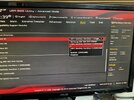yes the Windows is the first in the boot sequence and it is on the samsung 960 EVO M.2 NVMe drive. I do have a USB drive or can get one but all other computers in the house are Macs. I don't recall seeing a USB port enabler/disabler in the bios, but will look again.
-
Hi there and welcome to PC Help Forum (PCHF), a more effective way to get the Tech Support you need!
We have Experts in all areas of Tech, including Malware Removal, Crash Fixing and BSOD's , Microsoft Windows, Computer DIY and PC Hardware, Networking, Gaming, Tablets and iPads, General and Specific Software Support and so much more.
Why not Click Here To Sign Up and start enjoying great FREE Tech Support.
This site uses cookies. By continuing to use this site, you are agreeing to our use of cookies. Learn More.
Solved My DIY 2016 puter boots up I think but monitor window say no connection.
- Thread starter papasloane
- Start date
You are using an out of date browser. It may not display this or other websites correctly.
You should upgrade or use an alternative browser.
You should upgrade or use an alternative browser.

- Status
- Not open for further replies.
You need to have a good look around the BIOS because if the USB ports are disabled you have zero chance of fixing this without re enabling them.
Second thing that you need to do is find someone with a Windows computer so that you can download a Linux distro to your flash drive, the idea is to see if we can boot from that and access the Windows boot drive to see if it is bad, USB ports have to be first in the boot sequence to do this.
Second thing that you need to do is find someone with a Windows computer so that you can download a Linux distro to your flash drive, the idea is to see if we can boot from that and access the Windows boot drive to see if it is bad, USB ports have to be first in the boot sequence to do this.
Enabled all the USB ports, reset the optimized settings again, only option, exited and restarted. No change. Looking for someone with a Windows PC and enuf knowledge to make a Linux distro flash drive. Thanks again
I now have a Linux Mint DW6 or WD6, whatever is the latest LM, and I made it the boot and it worked. Now what do I do with it? ;>)
I now have a Linux Mint DW6 or WD6, whatever is the latest LM, and I made it the boot and it worked.
You should be happy for a start, you were looking at having a computer for a paperweight but with the help of PCHF you have saved it from the scrapheap
So So Sorry, I meant that the LM boot thing worked and I can see the Linux Mint that booted up. Unfortunately we still haven't got the Win10 to boot up yet and not sure how we proceed from here. Yes I am happy any and every time we have made progress.
Kind of afraid to mess around to much in LM as I know zip about Linux and don't want to screw it up
Kind of afraid to mess around to much in LM as I know zip about Linux and don't want to screw it up
Last edited by a moderator:
The fact that the computer works with Linux means that most if not all of your hardware looks to be ok.
Potential causes of the initial problem include Windows being corrupt and a failed boot drive.
Because the boot drive is detected the problem looks to be with Windows itself.
Have you tried removing and reseating the drive.
Do you get any on screen message such as restart and select proper boot device.
Is there any personal data on the drive.
Potential causes of the initial problem include Windows being corrupt and a failed boot drive.
Windows is the first in the boot sequence and it is on the samsung 960 EVO M.2 NVMe drive.
Because the boot drive is detected the problem looks to be with Windows itself.
Have you tried removing and reseating the drive.
Do you get any on screen message such as restart and select proper boot device.
Is there any personal data on the drive.
Hello Phillpower2, I removed and reseated the M.2 drive again, no change. Screen message upon booting up with the USB drive: GNU GRUB version 2.06-13 then in a boxed window: *start LMDE 6 64-bit, and subsequent lines are similar. If I press enter it goes on to LM. No restart and select proper boot drive. Yes I believe that the M.2 has not only Win10 but some personal data on it. Should I just buy a newer Samsung 990 NVMe M.2 or? Is there anyway to recover the data on the M.2? It may all be on 1 of the HDs anyway? Thanks again.
You would only get such a message when not booting from the Linux USB.
Shutdown the PC and remove the Linux USB, restart and enter the BIOS so that the boot sequence can be put back to the way that you had it, reference the below;
Restart the PC with the Samsung SSD as the first boot device and let us know if you get the restart and select proper device message to which I previously referred.
Shutdown the PC and remove the Linux USB, restart and enter the BIOS so that the boot sequence can be put back to the way that you had it, reference the below;
the Windows is the first in the boot sequence and it is on the samsung 960 EVO M.2 NVMe drive.
Restart the PC with the Samsung SSD as the first boot device and let us know if you get the restart and select proper device message to which I previously referred.
I think u may have misunderstood me. I remover the USB and restarted and it goes to the UEFI bios. Checked the Boot sequence and the Samsung 960 was first. It goes directly to that. I then put the USB back in and it stops at the screen in the attached photo. I then have to click on the top highlighted line to continue booting into LM. I tried moving the highlighted line down and hit enter and it went to just a older type bios screen. So the screen is from the boot with the USB. Well I hope this helps.
Attachments
I remover the USB and restarted and it goes to the UEFI bios. Checked the Boot sequence and the Samsung 960 was first. It goes directly to that.
The pic above is with the USB plugged in, after shutting down the PC can you remove the Linux USB, restart the PC and provide a BIOS picture of the Samsung SSD when it is first in the boot sequence.
That's the one and the good news is that the Samsung SSD is detected so chances are it is just Windows that is bad and needs to be clean installed.
You need a 16GB or above USB flashdrive, when ready go here for how to download you ISO etc, you want the option for use on another PC.
Once you have your ISO, take your two data drives offline, change the boot sequence so that the PC boots from USB, shutdown, put the USB flashdrive into one of the black USB 2.0 ports, restart and install Windows.
Any problems, you may ned to disable secure boot so that the PC can boot from your flashdrive.
You need a 16GB or above USB flashdrive, when ready go here for how to download you ISO etc, you want the option for use on another PC.
Once you have your ISO, take your two data drives offline, change the boot sequence so that the PC boots from USB, shutdown, put the USB flashdrive into one of the black USB 2.0 ports, restart and install Windows.
Any problems, you may ned to disable secure boot so that the PC can boot from your flashdrive.
I purchased Win10 in 2016 and installed it. In moving stuff around during our remodel projects it is lost. So I can't seem to locate the USB it came on nor the product key. Went to the site you said and copied the ISO onto a 32gb USB and it stopped during boot sequence and pop up as below in the pic. I made up the USB on an older Mac, on a MS-Fat format so I am not sure it is right. Still scouring 4.5 acres of junk for the original USB and/or the product key. Contacting the company I purchased it from, but no reply as of yet. Also scanned my Msft acct. but no key yet. Ideas?
Attachments
Sorry but we can`t vouch for anything that has been done any other than the way that was advised, I know zero about Macs so am unable to comment about it.
No need to worry about any product key as along with the MB details it is stored on the Microsoft servers and gets checked when you update Windows to make sure that the product key is being used with the correct MB.
You need to create the ISO on a Windows machine I`m afraid.
No need to worry about any product key as along with the MB details it is stored on the Microsoft servers and gets checked when you update Windows to make sure that the product key is being used with the correct MB.
You need to create the ISO on a Windows machine I`m afraid.
To avoid us having to ask for an update every couple of days and because the OPs original issue is resolved we will mark and close this thread.
Should you still need help with the second issue please start a thread on the Windows 10 forum.
Should you still need help with the second issue please start a thread on the Windows 10 forum.
- Status
- Not open for further replies.




